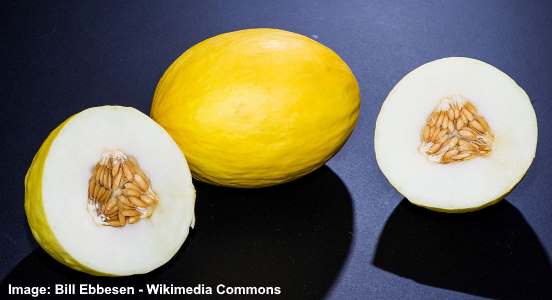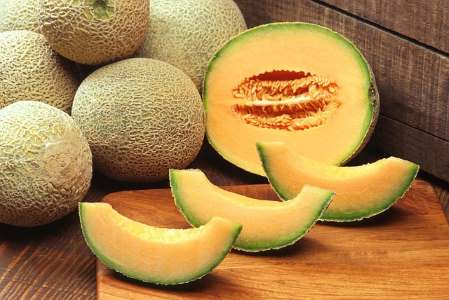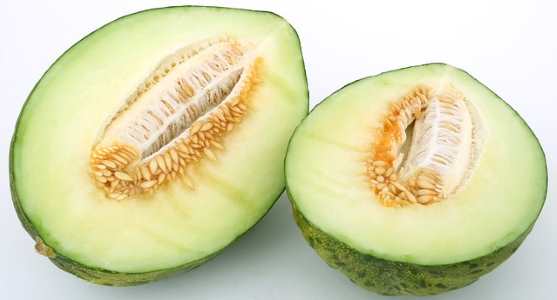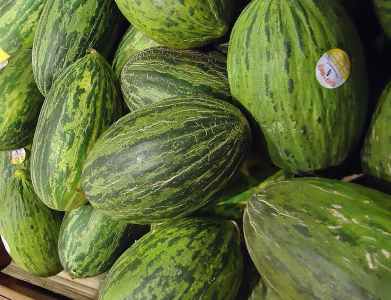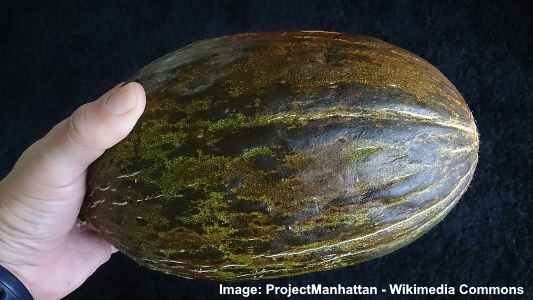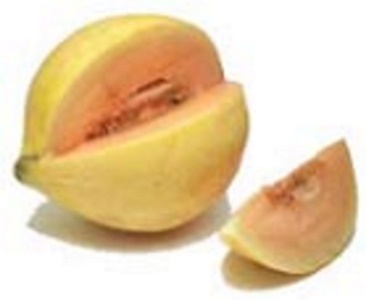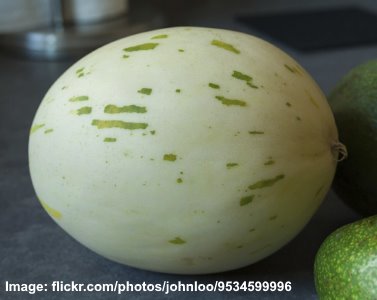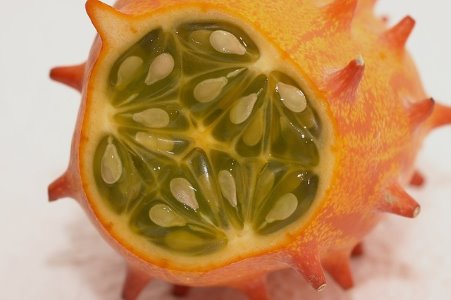Types of Melons: Different Varieties of Melons From Around the World
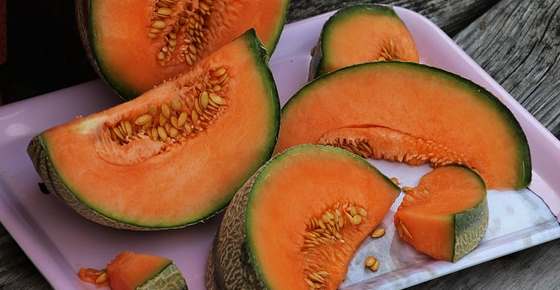
There are many types of melons that come in all shapes, sizes, and colors. Varieties of melon such as honeydew melons, cantaloupes, and watermelons are among the most popular kinds of melons consumed in summer. However, you don’t have to limit yourself to these yellow or green types of melons. There are many more kinds of sweet juicy melons to enjoy.
Melons originated in South Asia, Africa, India, and Iran and have been cultivated for thousands of years. Melons are botanically a type of berry in the Cucurbitaceae family of fruit.
Melons can be oblong, oval, perfectly round, have rough jagged skin or smooth skin. The juicy flesh in melons can be orange, yellow, red, pink, or green. Some melon varieties are small enough to easily hold in the palm of your hand. Other kinds of melons can grow to a weight of more than 200 lb. (90 kg)!
One thing about eating any type of melon is that they are among some of the sweetest and juiciest fruits you can consume.
In this article, you will learn about some of the most popular types of melons that you can enjoy.
Types of Melons (With Pictures and Names)
All types of popular melons are rich sources of vitamins, minerals, and essential nutrients. Also, the flesh of melons contains a lot of water and fiber, therefore, they are also very good for your digestion.
Muskmelons (a species of melon)
Muskmelon (Cucumis melo) is a variety of melon. This variety of melon includes a number of melon cultivars such as cantaloupes, honeydews, casaba, and Persian melons.
Some types of muskmelons are smooth-skinned varieties whereas others have light to pronounced netting over their green skin.
Let’s look in more detail at 16 well-known and some less-well-known varieties of melon.
Canary Melon
The Canary melon has bright smooth yellow skin, an oval elongated shape, and has a mildly sweet taste.
The name of this type of melon comes from the fact that the yellow skin resembles the canary bird.
Slicing a Canary melon in half reveals soft light green or creamy-yellowish flesh that is similar to a pear but tastes much sweeter. Some people describe the flavor as mildly tangy when compared to a honeydew melon. When this type of melon is ready to eat, the flesh will be extremely juicy and succulent and not too sweet.
Similar to honeydew melons, all the salmon-colored seeds in this golden melon are in the center of the fruit.
You know when a Canary melon is ripe when the melon looks bright yellow without any hints of green on it. Also, check the rind as it should have a waxy feel to it when fully ripe.
Canary melons grow to about 4 or 5 lb. (1.8 – 2.2 kg).
Cantaloupe Melon
Cantaloupe melons (Cucumis melo var. cantalupo) with their netted green and beige skin and deliciously sweet orange flesh are one of the most popular types of melon.
This type of melon came to the US and Europe from Asia in the late 1800s. European cantaloupes and North American cantaloupes are both round types of melon that have an unusual peel. The mesh-like markings and dark stripes on some types of cantaloupes may resemble the look of a basketball.
Cantaloupe melons are actually a type of muskmelon that have a floral aroma. The green rind covers light-orange flesh that is very sweet and juicy. The best way to eat these wonderful melons it to chop the flesh and eat it raw.
Many experts agree that green cantaloupes are unique among all the varieties of melon due to their smooth silky texture and aromatic fragrances.
If you want to know how succulent a fresh cantaloupe is, compare its weight with similar melons. The heavier the fruit, the more succulent it will be. Ripe cantaloupes should give off a delightful floral aroma and be very slightly soft to touch.
These ball-shaped green beige melons can grow between 1 lb. and 11 lb. (0.45 – 5 kg).
Other types of cantaloupe melons include the Asian Cantaloupe with lightly netted green skin and the Infinite Gold cantaloupe with dark orange flesh. One Israeli type of melon is the Galia cantaloupe with green flesh and a distinct banana aroma.
Ananas Melon (a Variety of Muskmelon)
The Ananas type of muskmelon has an oval rather than round shape as the cantaloupe has. These are very juicy muskmelons that have pale creamy flesh and a smooth texture.
“Ananas” is actually the name for pineapple in many European languages. Of course, pineapples aren’t melons; however, the name well describes the pleasant pineapple aromas that come from a perfectly ripe Ananas melon.
Honeydew Melon
Honeydew melons are oval-shaped with pale green peel and flesh of a similar color. Honeydews are at their sweetest when left to ripen fully on the vine.
Being a type of muskmelon, honeydews (also called honeymelons) have silky smooth flesh that tastes wonderful. Unlike types of cantaloupes, honeymelons don’t have brightly colored flesh. However, that doesn’t detract from the fact that these are a deliciously sweet type of melon.
Honeydews are one of the most popular types of winter melons available in North America. This is due to their long shelf life and exceptional sweetness when they have been allowed to ripen slowly.
To tell when a honeydew melon is ripe and ready to eat, gently press the blossom end of this pale green fruit to see if it gives lightly fruity aroma.
Honeydew melons generally range in weight from 4 to 8 lb. (1.8 to 3.6 kg). In many countries, you can expect to find these muskmelons in stores all year round.
Watermelon
The watermelon (Citrullus lanatus) is one of the largest types of melon. This is a green-skinned melon that often has dark-green stripes. The thick melon rind hides vibrant red melon flesh that is very succulent.
The most common type of watermelon is the kind with red or pink colored flesh. However, you can also find varieties with orange or even yellow flesh. Most types of watermelon have lots of seeds throughout the flesh, although seedless watermelons are also becoming more popular.
Watermelons definitely belong on the list of large types of melon. In some cases, they can grow up to 24” (60 cm) in diameter and weigh between 20 and 51 lb. (9 – 23 kg).
Korean Melon
Korean melons are a yellow type of oval muskmelon with light stripes on the skin and light-colored flesh.
Unlike many types of muskmelons, Korean melons have smooth yellow skin and white, almost translucent, crisp flesh. This bright yellow melon is incredibly sweet and some say it tastes similar to honeydew melons or pears.
One of the interesting facts about Korean melons is that their skin is so thin that it is edible. Just make sure to thoroughly wash the melon if you plan on eating it with its skin.
Despite being a small variety of melon, Korean melons are still very popular due to their unique taste. A ripe Korean melon can weigh around 1.5 lb. (700 g) and only be about 5” (12.5 cm) long.
Santa Claus Melon
Santa Claus melons are a large oval green variety of melon with pale-green flesh and a thick dark blotchy rind.
Some say that the color of the Santa Claus melon skin (also called Christmas melon) looks like a watermelon but it has the shape of a canary melon. However, the skin on some varieties of this type of melon can also be a greenish-yellow color.
The light green flesh in the melon is mildly sweet and tastes similar to a honeydew melon. You can usually tell which are the sweet varieties of Santa Claus melons by the color of the rind – the yellower the color, the sweeter the taste.
To tell if this kind of melon is ripe, you should gently squeeze the blossom end to see if it gives slightly. Due to the thick green/yellow skin, there is little aroma from fully ripened Santa Claus melons.
These large green melons can weigh up to 9 lb. (4 kg).
Honey Globe Melon
Honey Globe melons are a large and white type of melon with pale green flesh and a round to oval shape.
The white melon’s webbed rind can sometimes have markings of green lines on it. This gives the melon a very striking look when compared to other green and yellow types of melon.
Many describe this type of melon as one of high quality and extremely sweet. And it’s the delicious taste of the Honey Globe that sets this apart from other melons.
The light green flesh is thick and succulent and, because over 15% of its weight is sugar, it’s one of the sweetest melons. Biting into chunks of Honey Globe melon, you will find that the flesh is chewable and tender.
Expect the average Honey Globe melon to weigh around 4 lb. (1.8 kg)
Valencia Melon
Valencia melons have an elongated oval shape with thick dark green skin and pale white juicy flesh.
The Valencia melon originates in Spain and looks like a shorter version of the Santa Claus melon. Biting into succulent chunks of Valencia melon you will find that the flesh is sweet, tender and very refreshing.
Due to the thick melon skin, it has a very long shelf life and is still edible in December and January. This is the reason why this variety is also called the Valencia Winter melon.
One unusual type of melon is a variegated Valencia melon. This melon variety has striking yellow and dark green markings on its thick skin.
Sprite Melon
The pale-yellow colored Sprite melon is one of the smaller types of melons that has firm succulent flesh. Sprite melons originate from Japan and they are now widely grown in North Carolina.
Compared to other melons, the Sprite melon is one of the sweetest melons you can buy. This is due to the ivory-colored flesh containing 18% sugar, which is nearly one-quarter more than other melons. It is also one of the smallest melons you can buy with its average size being that of a grapefruit.
The yellowish skin has a netted-look similar to cantaloupes but a sweet taste similar to honeydews. However, as already mentioned, cantaloupes and honeydews can compete with this small compact melon when it comes to sweetness.
The small type of melon weighs between 1 and 1.5 lb. (0.5 to 0.7 kg).
Jade Dew Melon
Jade Dew is a delicious type of melon that has pale-yellowish flesh and a sweet crunchy taste.
This medium-sized oval-shaped melon has a pale semi-webbed rind that covers its delightfully tasty flesh. Unlike some types of cantaloupes, the Jade Dew melon has a distinct crunch when you bite into its flesh.
Expect a fully ripened Jade Dew melon to weight about 4.4 lb. (2 kg).
Crenshaw Melon
Crenshaw melon has light yellow and green coloring on its hard rind. Compared to other regular melons, the Crenshaw melon has an unusual shape. It is somewhat spherical with a flattened bottom at the blossom end and tapered pointed top at the stem end.
Slicing this yellowish melon, you will find it has creamy tender flesh that is the color of light peaches. The taste of the Crenshaw melon is very sweet with slightly spicy overtones.
A regular Crenshaw melon will weigh on average between 8 and 10 lb. (3.6 to 4.5 kg).
Sharlyn Melon
Sharlyn melons are a type of oval muskmelon that have the typical webbing of many cantaloupes on the surface of their light-orange skin.
One of the differences between Sharlyn melons and cantaloupes is that they are not as sweet. The pale orange flesh is creamy and fruity without being overly sweet. Some say that Sharlyn melons resemble the taste of pineapples.
The orange color of their skin is one of the signs that a Sharlyn melon is ripe. The thin skin and firm flesh should give a little when you press it.
Sharlyn melons are among the larger melon varieties with their average weight being between 6 and 9 lb. (2.7 to 4 kg).
Snow Leopard Melon
The Snow Leopard melon is an exotic type of melon that has ivory colored skin with green markings on it.
Sometimes called the Ivory Gaya, this type of small oblong melon has creamy white flesh that is very soft and extremely juicy. Many say that the sweet taste of Snow Leopard melons has honey and pear overtones.
To tell if a Snow Leopard Melon is ripe, it should give off a rich melon aroma and the light-colored skin should give slightly when pressed.
This small variety of melon weighs around 2 lb. (0.9 kg) when ripe and ready to eat.
Horned Melon
The Horned Melon (Cucumis metuliferus) with its vibrant orange skin and soft spikes is one of the most unusual melons you will come across.
This type of spiky melon originates in South Africa but is now gown in many countries around the world. It is also called Kiwano, the African Horned Cucumber, the jelly melon, and spiked melon.
When you cut open a horned melon, you will find that the gelatinous lime-green flesh is full of edible seeds. The fruity taste of Horned melons is surprisingly refreshing.
In many ways, the Horned melon is unlike any other type of melon when it comes to texture. Rather than having firm tender flesh like cantaloupes or honeydews, it resembles the texture of passion fruits or pomegranates.
Apart from being one of the most unusual melons you can find, it is also one of the smallest. An average Horned melon is only 3.5” (9 cm) in length and weighs just over 7 oz. (0.2 kg).
Bitter melon
Bitter melon (Momordica Charantia) was originated from South India and is grown in Asia, Africa, and the Caribbean. There are different cultivars of this type of melon in a variety of shapes and sizes.
The bitter melon cultivar is common in China has long shape which becomes narrower at the ends. This type of bitter melon is usually 20–30 cm (7.9–11.8 in) long and has light green color with lightly bumpy skin.
The bitter melon cultivar which is more common in India is narrower with pointed ends, and the surface is more bumpy than the Chinese cultivar with more prominent ridges. It is usually darker shade of green.
Some cultivars of bitter melon have miniature size of 6–10 cm (2.4–3.9 in), which are often used as stuffed vegetables. Bitter melon is commonly used in Asian cuisine.
How to Choose the Perfect Melon
It is not always easy to know when a melon is ripe and ready to eat. Some varieties of melons only ripen on the vine, whereas others become sweeter and juicier after they are harvested.
If you want to select the best melon every time, here are a few tips:
- Inspect the skin to make sure that there are no bruising or soft patches.
- Checking the skin color is also important. Yellow melons such as canary melons should be vibrant, whereas honeydews should have a pale-yellow color. Avoid ones that have green patches. Depending on the variety, the rind color of muskmelons and cantaloupes should be light green, golden, or orange under the beige-colored netting.
- Check the weight because heavier melons tend to be more succulent and juicier.
- Do the smell test because popular varieties of melon such as honeydews and cantaloupes should have a fragrant, fresh aroma.
- Gently tap watermelons to make sure they have a hollow sound.
Related articles:

